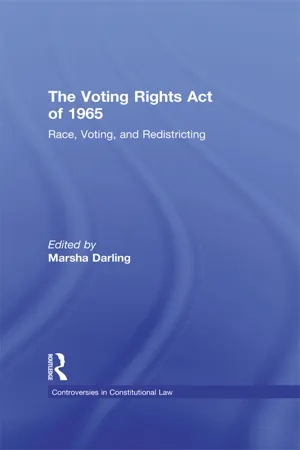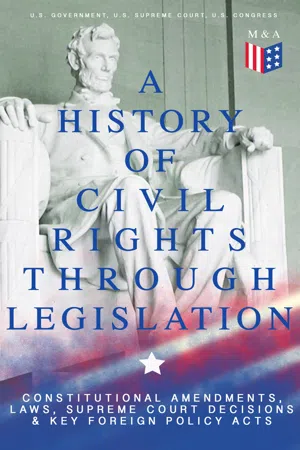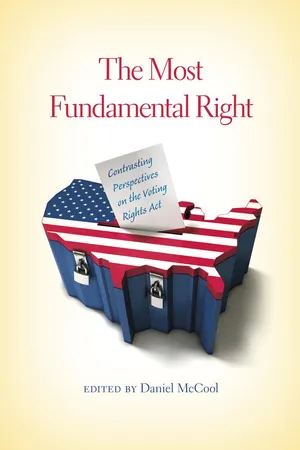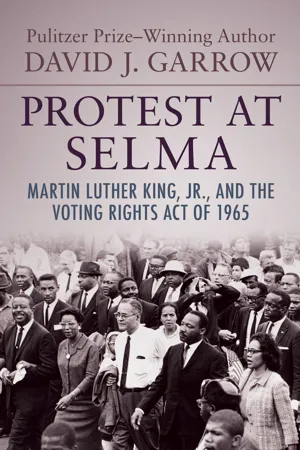History
Voting Right Act of 1965
The Voting Rights Act of 1965 was a landmark piece of legislation in the United States that aimed to overcome legal barriers at the state and local levels that prevented African Americans from exercising their right to vote. It prohibited discriminatory voting practices, such as literacy tests and poll taxes, and provided federal oversight of elections in areas with a history of voter suppression. The Act played a crucial role in advancing civil rights and political participation for African Americans.
Written by Perlego with AI-assistance
Related key terms
7 Key excerpts on "Voting Right Act of 1965"
- eBook - ePub
The Voting Rights Act of 1965
Race, Voting, and Redistricting
- Marsha Darling(Author)
- 2013(Publication Date)
- Routledge(Publisher)
THE VOTING RIGHTS ACT OF 1965 AUGUST 6, 1965Be it enacted by the Senate and House of Representatives of the United States of America in Congress assembled, That this Act shall be known as the “Voting Rights Act of 1965”.SEC . 2. No voting qualification or prerequisite to voting, or standard, practice, or procedure shall be imposed or applied by any State or political subdivision to deny or abridge the right of any citizen of the United States to vote on account of race or color.SEC . 3. (a) Whenever the Attorney General institutes a proceeding under any statute to enforce the guarantees of the fifteenth amendment in any State or political subdivision the court shall authorize the appointment of Federal examiners by the United States Civil Service Commission in accordance with section 6 - eBook - ePub
A History of Civil Rights Through Legislation: Constitutional Amendments, Laws, Supreme Court Decisions & Key Foreign Policy Acts
Declaration of Independence, U.S. Constitution, Bill of Rights, Complete Amendments, The Federalist Papers, Gettysburg Address, Voting Rights Act, Social Security Act, Loving v. Virginia and more
- U.S. Government, U.S. Supreme Court, U.S. Congress(Authors)
- 2017(Publication Date)
- Madison & Adams Press(Publisher)
Voting Rights Act
(1965)Table of ContentsThe first page of the Voting Rights Act.Passage contains an image
The last page of the Voting Rights Act.Passage contains an image
Eighty-ninth Congress of the United States of America At the First Session Begun and held at the city of Washington, on Monday, the fourth day of December, one thousand nine hundred and sixty-fiveAN ACT To enforce the fifteenth amendment to the Constitution of the United States, and for other purposes. Be it enacted by the Senate and House of Representatives of the United States of America in Congress assembled, That this Act shall be known as the "Voting Rights Act of 1965".Sec. 2.No voting qualification or prerequisite to voting, or standard, practice, or procedure shall be imposed or applied by any State or political subdivision to deny or abridge the right of any citizen of the United States to vote on account of race or color.Sec. 3. - eBook - ePub
The Most Fundamental Right
Contrasting Perspectives on the Voting Rights Act
- (Author)
- 2012(Publication Date)
- Indiana University Press(Publisher)
11· “The Voting Rights Act is a sacred symbol of American Democracy.”12· “The Voting Rights Act of 1965 has been widely hailed as the single most important achievement of our civil rights laws.”13· “The historic accomplishments of the Voting Rights Act are undeniable.”14The VRA is a unique piece of legislation, divided into permanent and temporary sections. Section 2 is permanent, i.e., it does not sunset on a specific date. It outlaws election procedures that “result in the denial or abridgment of the right of any citizen of the U.S. to vote on account of race or color.” The act also permanently outlaws literacy and moral requirements and other such “test or device” that denies or abridges the voting rights of racial minorities.15Sections 4 through 9 and 203 are temporary, and thus have to be periodically renewed. Of these, Section 5 requires “preclearance” of all changes in voting laws or procedures in certain states and political subdivisions – “covered jurisdictions” – that meet criteria specified in Section 4 (see chapter 2 ). The objective of Section 5 was, in the words of the U.S. Supreme Court, to “shift the benefit of time and inertia from the perpetrators of evil to the victim.”16 Sections 6 through 9 authorize the U.S. government to deploy federal examiners to oversee voter registration and federal observers to oversee polling places.17 Another temporary provision, Section 203, was added in 1975. It requires that voting materials be provided in languages other than English and assistance be provided to individuals with limited English proficiency in certain areas of the country.18 - eBook - ePub
The Laws That Shaped America
Fifteen Acts of Congress and Their Lasting Impact
- Dennis W. Johnson(Author)
- 2009(Publication Date)
- Routledge(Publisher)
144African-American voting registration had begun in earnest before the passage of the 1965 Voting Rights Act. The Southern Christian Leadership Conference’s Voter Education Project, begun in 1962 and finishing in 1964, gave funds and coordinated the activities of the NAACP, the SCLC, SNCC, CORE, and the National Urban League. The Voter Education Project was successful in many southern states, but was a failure in Mississippi.145 Likewise, the Department of Justice had filed seventy-one suits, together with broad-based litigation against Alabama, Mississippi, and Louisiana during the eight years before passage of the Voting Rights Act.146The number of African-American voters in the South increased dramatically, thanks to the Voter Education Project and, especially in areas of greatest resistance, to Voting Rights Act enforcement. With only 1.1 million African-Americans registered in 1964, the number had risen to 3.1 million in 1969, with nearly 500 African-Americans holding elective office that year in the lower South.147Discrimination and voting irregularities still persisted, but the focus was now shifting from outright denial of the vote to vote dilution. By 1988, the gap between black and white registration rates had narrowed considerably.148 The gap of 49.9 percent in Alabama in 1965 had shrunk to just 6.6 percent in 1988; in Mississippi the 63.2 percent gap closed to 6.3 percent; and in Louisiana a 48.9 percent gap in 1965 became a 2.0 gap in favor of black voters in 1988.The more ominous problem for African-Americans and Hispanics was voter dilution. Multi-member districts, at-large elections, appointing rather than electing officials, and gerrymandering were adopted in cities throughout the South in order to dilute the strength of black neighborhoods. In 1969, a Supreme Court decision looked at such practices in Mississippi and Virginia, and ruled that any such changes were subject to the pre-clearance provisions found in section 5 of the Voting Rights Act.149 Up until this time, the pre-clearance section was relatively unused, but now the floodgates opened. During its first five years (1965–1969), there were just 323 section 5 changes submitted to the Attorney General; during the next five years, there were 4,153 changes requested. But, in the 1980s and 1990s, the number exploded, and in 2000–2002, there were almost 50,000 such requests made.150 - eBook - ePub
Ballot Blocked
The Political Erosion of the Voting Rights Act
- Jesse H. Rhodes(Author)
- 2017(Publication Date)
- Stanford University Press(Publisher)
“The Voting Rights Act was aimed at the subtle, as well as the obvious, state regulations which have the effect of denying citizens their right to vote because of their race,” the majority pronounced. “Moreover, compatible with the decisions of this Court, the Act gives a broad interpretation to the right to vote, recognizing that voting includes ‘all action necessary to make a vote effective ’” (the internal quotation comes directly from the statute, with emphasis added). 147 By interpreting the phrase “make a vote effective” broadly to mean “make a vote capable of exercising substantive political power” rather than simply “make a vote legally valid,” an understanding grounded in the Court’s recent reapportionment decisions, the majority established a jurisprudential rationale for reading the statute to require Section 5 coverage of rules not pertaining directly to the process of voting. 148 But the majority opinion also relied heavily on the historical claim that “in passing the Voting Rights Act, Congress intended that state enactments such as those involved in the instant cases be subject to the Section 5 approval requirements” (emphasis added). 149 The bulk of the opinion was a defense of this construction of congressional intent - eBook - ePub
American Constitutional Law, Volume II
The Bill of Rights and Subsequent Amendments
- Ralph A. Rossum, Alan Tarr, Vincent Phillip Munoz(Authors)
- 2019(Publication Date)
- Routledge(Publisher)
Petitioner Shelby County, in the covered jurisdiction of Alabama, sued the Attorney General in Federal District Court in Washington, D.C., seeking a declaratory judgment that Sections 4 and 5 are facially unconstitutional as well as a permanent injunction against their enforcement. The District Court upheld the Act, finding that the evidence before Congress in 2006 was sufficient to justify reauthorizing Section 5 and continuing Section 4’s coverage formula. The D.C. Circuit affirmed. After surveying the evidence in the record, that court accepted Congress’s conclusion that Section 2 litigation remained inadequate in the covered jurisdictions to protect the rights of minority voters, that Section 5 was therefore still necessary, and that the coverage formula of Section 4 continued to pass constitutional muster. The Supreme Court granted certiorari. Opinion of the Court: Roberts , Scalia, Kennedy, Thomas, Alito. Concurring opinion: Thomas . Dissenting opinion: Ginsburg , Breyer, Sotomayor, Kagan.CHIEF JUSTICE ROBERTS delivered the opinion of the Court.The Voting Rights Act of 1965 employed extraordinary measures to address an extraordinary problem. Section 5 of the Act required States to obtain federal permission before enacting any law related to voting – a drastic departure from basic principles of federalism. And Section 4 of the Act applied that requirement only to some States – an equally dramatic departure from the principle that all States enjoy equal sovereignty. This was strong medicine, but Congress determined it was needed to address entrenched racial discrimination in voting, “an insidious and pervasive evil which had been perpetuated in certain parts of our country through unremitting and ingenious defiance of the Constitution.” South Carolina v. Katzenbach (1966). As we explained in upholding the law, “exceptional conditions can justify legislative measures not otherwise appropriate.” Reflecting the unprecedented nature of these measures, they were scheduled to expire after five years.Nearly 50 years later, they are still in effect; indeed, they have been made more stringent, and are now scheduled to last until 2031. There is no denying, however, that the conditions that originally justified these measures no longer characterize voting in the covered jurisdictions. By 2009, “the racial gap in voter registration and turnout [was] lower in the States originally covered by §5 than it [was] nationwide.” Since that time, Census Bureau data indicate that African-American voter turnout has come to exceed white voter turnout in five of the six States originally covered by §5, with a gap in the sixth State of less than one half of one percent.At the same time, voting discrimination still exists; no one doubts that. The question is whether the Act’s extraordinary measures, including its disparate treatment of the States, continue to satisfy constitutional requirements. As we put it a short time ago, “the Act imposes current burdens and must be justified by current needs.” - eBook - ePub
Protest at Selma
Martin Luther King, Jr., and the Voting Rights Act of 1965
- David J. Garrow(Author)
- 2015(Publication Date)
- Open Road Media(Publisher)
While such concrete gains came only after blacks themselves had been elected, 49 a number of studies indicated that substantial black voting even in the absence of black elected officials did produce some improvements for black citizens. In the wake of black voting, a political scientist who studied one Mississippi county concluded, perhaps “the most basic change the Negro could see was the curbing of official violence.” 50 Wrote two other scholars, “Police brutality tends to decline and, to a lesser extent, the entire administration of justice tends to improve after southern Negroes become active members of the electorate.” 51 While improvements such as these were being registered in many parts of the Deep South as the 1960s closed, the advent of the Nixon administration early in 1969 posed a serious threat to the maintenance of even the most easygoing enforcement of the Voting Rights Act’s key provisions. As some backers of the 1965 act had come to realize even during the tenures of Katzenbach and Ramsey Clark, the enforcement provisions of the act granted a very large amount of discretionary authority to the attorney general. That this need not always work to blacks’ advantage was brought home clearly when John N. Mitchell took charge at Justice in 1969. 52 Mitchell’s first visible action in the voting rights field took place on June 26, 1969 when he testified at the fourth day of hearings that House Judiciary Subcommittee No. 5 was conducting on the extension of the Voting Rights Act. Lacking reenactment, sections 4 and 5—the heart of the act—would expire in August 1970, five years after their initial passage. Mitchell proposed that the attorney general be granted the power to use examiners and observers anywhere in the country and that literacy “tests and devices” be suspended throughout the nation so that the “regional” character of the act, heretofore aimed only at the South, would be removed
Learn about this page
Index pages curate the most relevant extracts from our library of academic textbooks. They’ve been created using an in-house natural language model (NLM), each adding context and meaning to key research topics.






